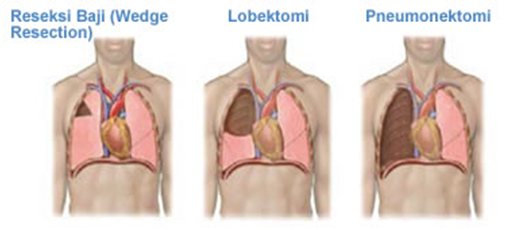Treatment of lung cancer usually considers aspects of patient history, stage of cancer, as well as general health condition of the patient. The following will explain some treatment is generally performed in patients with lung cancer.
Surgery for Lung Cancer
Surgery in lung cancer is the act of removal of the tumor tissue and surrounding lymph nodes. Surgery is usually done for cancer that has not spread to other tissues beyond the lungs. Surgery usually is only one choice of treatment action in NSCLC and is confined to one part of the lung up to stage IIIA.
Several types of surgery that may be used to treat NSCLC, among others:
- Pneumonectomy: whole lung (left or right) was appointed in this operatio
- lobectomy: lung lobe removed in this operation
- Segmentectomy or wedge resection: a part of a lobe is removed in this operation.
Surgery has a failure rate (death rate) of about 4.4% which depends also on the patient's lung function and other risks.
Sometimes in cases of advanced-stage lung cancer where the number of accumulated fluid in the chest cavity (pleural effusion), the doctor needs to make a small hole in the chest to remove fluid.
Side effects of surgery that may arise after surgery, including chronic bronchitis (especially in the former active smokers).
Radiotherapy for Lung Cancer
Radiation is sometimes used as a primary treatment of lung cancer. It may be used for people who are not healthy enough to undergo surgery. For other cancer patients, radiation to shrink the cancer was done (done before the surgery).
In cases of advanced cancer, radiation also can be used to relieve symptoms such as pain, bleeding, and difficulty swallowing.
Often performed photodynamic therapy (PDT) to treat lung cancer that can be operated. And has the potential to treat tumors hidden and not visible on chest X-ray examination.
Side effects of radiation, including: skin problems, nausea, vomiting, and fatigue. Radiation to the chest can also cause damage to the lungs and difficulty breathing or swallowing.
Side effects of radiation therapy on the (lung cancer that has spread to) the brain usually become serious setelah1 or 2 years of treatment, which include: memory loss, headaches, problems with thinking, and lack of sexual desire.
Chemotherapy for Lung Cancer
SCLC Patients primarily treated with chemotherapy and radiation because surgery is usually not a significant effect on survival (survival).
Primary Chemotherapy is usually given in cases of metastatic NSCLC who have (spread).
The use of combinations of chemotherapy drugs on tumor type suffered. In patients with NSCLC are usually treated with cisplatin or carboplatin in combination with gemcitabine, paclitaxel, docetaxel, etoposide, or vinorelbine. While in patients with SCLC, frequently used drug cisplatin and etoposide. Or in combination with carboplatin, gemcitabine, paclitaxel, vinorelbine, topotecan, and irinotecan are also used.
Therapeutic Target
Application of usual therapeutic targets for the treatment of lung cancer at stage 3 and 4 who did not respond to other treatments. There are two kinds of targeted therapies most commonly used, ie.
- Erlotinib (Tarceva ®)
Cancer cells are covered by a protein called EGFR (Epidermal Growth Factor Receptor), which helps cancer cells to divide. Tarceva works by not allowing EGFR to instruct the cancer cells to grow. Tarceva in NSCLC patients may be given to prolong life expectancy. Box Tarceva works better in patients with non-smokers or women younger age (before menopause). And easy to be consumed every day because of the shape of pills.
- Bevacizumab (Avastin ®)
Bevacizumad an antibody directed against the protein to help tumor cells to form new blood vessels. These drugs can prolong survival of patients with advanced NSCLC, and is usually given in combination with the chemotherapy combination of carboplatin and paclitaxel. Bevacizumab is usually given by intravenous infusion and generally have side effects such as bleeding in the lungs.

Lung cancer originates from tissues of the lung, usually from the cells lining of the air passages. The two major types are small cell lung cancer and non-small cell lung cancer. These types are diagnosed based on how the cells look under a microscope. More than 80% of all lung cancers belong to the non-small cell type. The 3 main sub-types of non-small cell lung cancer are adenocarcinoma, squamous cell carcinoma and large cell carcinoma. Lung cancer treatment Germany
ReplyDelete